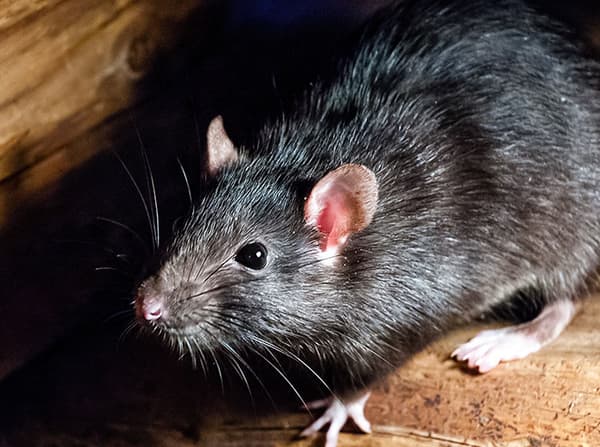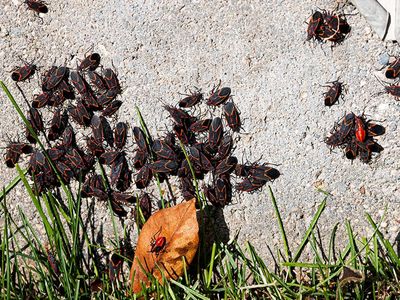What do roof rats look like?
Roof rats are medium-sized rodents, typically measuring 5 to 7 inches long—before you even count the tail. Their tails are another 6 to 9 inches, long, thick, and almost completely hairless. These rats have sleek bodies built for climbing, with pointed snouts, large ears, and beady black eyes. Their overall shape is more slender than a typical Norway rat, which helps them squeeze into tight upper spaces like attics and wall voids.

Why are roof rats also called black rats and ship rats?
Roof rats go by a few different names, each offering a clue about their habits and history:
- Roof rat: They tend to infest the upper parts of homes and buildings, like attics, rafters, and rooflines.
- Black rat: Many roof rats have dark brown to black fur, giving them this nickname.
- Ship rat: Historically, they were common stowaways on ships, where they spread disease and infested cargo.
No matter what you call them, they’re trouble once they move into your Pennsylvania home.
Do roof rats bite?
Roof rats can bite, but it’s rare. They’re skittish and would much rather avoid you than confront you. However, here’s what to know just in case:
- Their bites are painful due to sharp teeth and strong jaws.
- They are not known carriers of rabies.
- They can transmit rat-bite fever, a serious bacterial infection.
- Any bite or scratch from a rodent should be cleaned thoroughly and checked by a medical professional.
Avoiding direct contact is always best, especially in areas where rats may be nesting.
Do roof rats carry disease?
Yes, and quite a few. Roof rats can carry and transmit:
- Salmonellosis, leptospirosis, trichinosis, E. coli, and typhus
- Diseases via indirect contact through contaminated surfaces, droppings, or urine
- Ticks and fleas that carry Rocky Mountain spotted fever, bartonellosis, and Lyme disease
Their presence poses a serious health risk, especially in kitchens, attics, and storage areas.
How fast do roof rats multiply?
Very quickly. A single roof rat can produce 4 to 6 litters per year, with each litter averaging 6 to 8 pups. Those pups can begin reproducing in as little as two months. If left unchecked, a few roof rats can turn into a full-blown infestation in no time.
Will roof rats damage my property?
Roof rats are incredibly destructive. Here’s how they create problems for Pennsylvania homeowners:
- Droppings and urine can stain and contaminate insulation, furniture, and storage boxes.
- They chew holes in siding, roofing, and interior walls.
- They tear up insulation to build nests.
- Their chewing can damage wiring, which increases fire risk.
- Stored food, belongings, and paperwork can all become nesting material or chew toys.
You definitely don't want these pests living inside your home.
How do roof rats get inside?
Despite their name, roof rats don’t always enter from above—but they certainly prefer it. They’re expert climbers and use a variety of methods to access rooftops and upper levels:
- Scaling tree branches that touch the home
- Running along utility lines and cables
- Climbing brick, siding, or drainpipes
- Entering attic vents or gaps around chimneys and soffits
- In some cases, chewing a hole near the foundation and climbing up through wall voids
Once inside, they nest in attics, eaves, and other quiet, undisturbed areas.
How can I tell if I have a roof rat infestation?
You may not see roof rats right away, but the signs of their presence will become more obvious over time:
- Thumping, scratching, or scurrying sounds, especially at night
- A musty or urine-like odor in your attic
- Black, rice-sized droppings in cabinets or along baseboards
- Greasy rub marks on walls or beams
- Chewed openings or gnaw marks on wood, drywall, or food containers
If you suspect you have roof rats, schedule a professional inspection.
How do I get rid of roof rats?
Contact Evergreen Pest Solutions for help exterminating roof rats. Our local PA pest control team offers effective pest control services for homes and businesses that address rats and mice.
Can I stop roof rats from infesting?
In most cases, it is possible to keep roof rats out, but it takes knowledge and experience. We recommend having a professional handle your rodent proofing, baiting, trapping, and other essential rodent management strategies. You definitely don't want these pests slipping past poor defenses. Their presence in your home can lead to many health issues and property damage.








